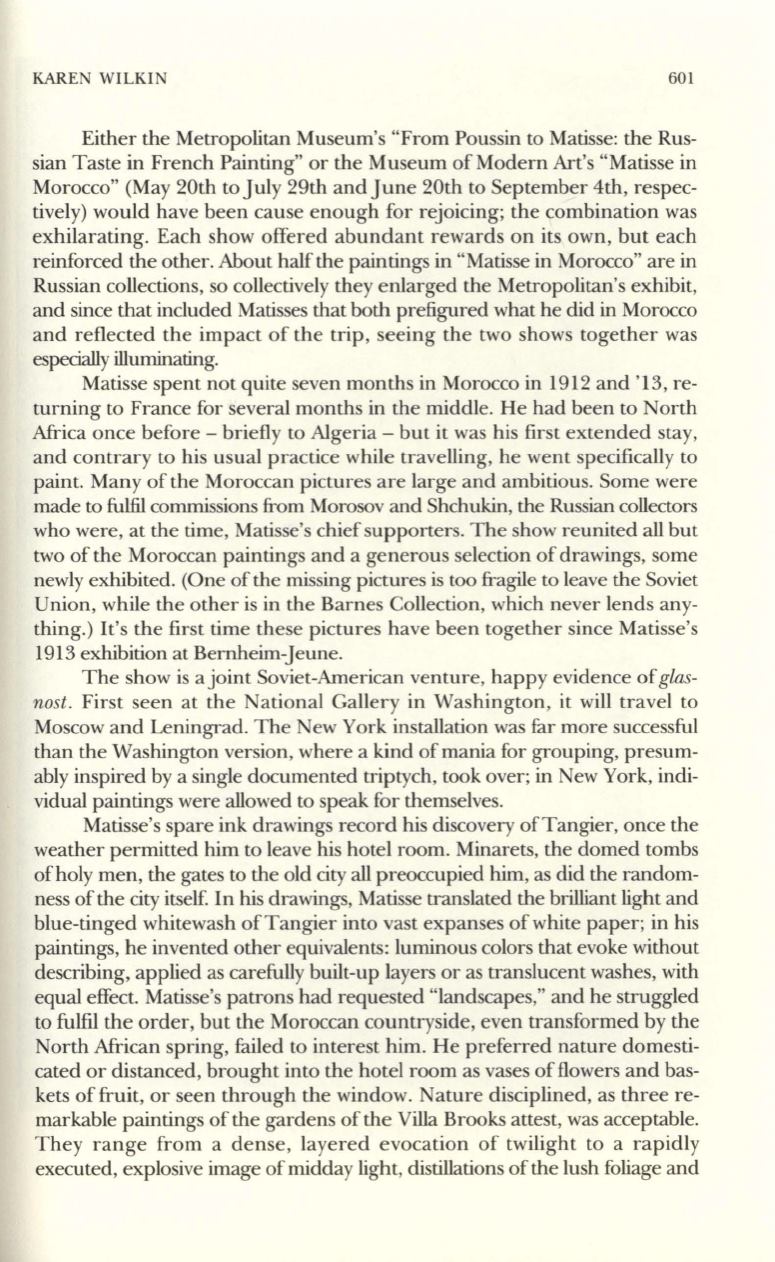
KAREN WILKIN
601
Either the Metropolitan Museum's "From Poussin to Matisse: the Rus–
sian Taste in French Painting" or the Museum of Modern Art's "Matisse in
Morocco" (May 20th to July 29th and June 20th to September 4th, respec–
tively) would have been cause enough for rejoicing; the combination was
exhilarating. Each show offered abundant rewards on its own, but each
reinforced the other. About half the paintings in "Matisse in Morocco" are in
Russian collections, so collectively they enlarged the Metropolitan's exhibit,
and since that included Matisses that both prefigured what he did in Morocco
and reflected the impact of the trip, seeing the two shows together was
especially
illuminating.
Matisse spent not quite seven months in Morocco in 1912 and ' 13, re–
turning to France for several months in the middle. He had been to North
Africa once before - briefly to Algeria - but it was his first extended stay,
and contrary to his usual practice while travelling, he went specifically to
paint. Many of the Moroccan pictures are large and ambitious. Some were
made to fulfil commissions from Morosov and Shchukin, the Russian collectors
who were, at the time, Matisse's chief supporters. The show reunited all but
two of the Moroccan paintings and a generous selection of drawings, some
newly exhibited. (One of the missing pictures is too fragile to leave the Soviet
Union, while the other is in the Barnes Collection, which never lends any–
thing.) It's the first time these pictures have been together since Matisse's
1913 exhibition at Bernheim-Jeune.
The show is a joint Soviet-American venture, happy evidence of
glas–
nost.
First seen at the National Gallery in Washington, it will travel to
Moscow and Leningrad. The New York installation was far more successful
than the Washington version, where a kind of mania for grouping, presum–
ably inspired by a single documented triptych, took over; in New York, indi–
vidual paintings were allowed to speak for themselves.
Matisse's spare ink drawings record his discovery of Tangier, once the
weather permitted him to leave his hotel room. Minarets, the domed tombs
of holy men, the gates to the old city all preoccupied him, as did the random–
ness of the city itself. In his drawings, Matisse translated the brilliant light and
blue-tinged whitewash ofTangier into vast expanses of white paper; in his
paintings, he invented other equivalents: luminous colors that evoke without
describing, applied as carefully built-up layers or as translucent washes, with
equal effect. Matisse's patrons had requested "landscapes," and he struggled
to fulfil the order, but the Moroccan countryside, even transformed by the
North African spring, failed to interest him. He preferred nature domesti–
cated or distanced, brought into the hotel room as vases of flowers and bas–
kets of fruit, or seen through the window. Nature disciplined, as three re–
markable paintings of the gardens of the Villa Brooks attest, was acceptable.
They range from a dense, layered evocation of twilight to a rapidly
executed, explosive image of midday light, distillations of the lush foliage and


